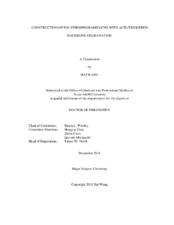Construction of Polyphosphoramidates with Acid-Triggered Backbone Degradation
Abstract
This dissertation focuses on the development of advanced synthetic methodologies to afford well-defined polyphosphoramidates (PPAs) containing acid-labile backbone linkages (phosphoramidate). By applying these methodologies, a library of monomers and corresponding polymers could be produced with various functionalities, hydrophilicities, and degradation rates. Further, PPA-based pH-responsive drug delivery systems were developed and exhibited accelerated drug release profiles under acidic conditions compared to neutral conditions, which was demonstrated to enhance the efficacy of an anticancer drug.
In the first study, highly water-soluble PPAs with acid-labile backbone linkages were prepared readily under basic conditions via organobase-catalyzed ring-opening polymerization (ROP) of a five-membered-ring monomer. The ROP kinetics were explored, demonstrating these polymerizations proceeded in a controlled manner under basic conditions via the selective cleavage of P−O bonds during the ROP. Degradation studies demonstrated these PPAs underwent rapid backbone degradation under acidic conditions through the cleavage of P−N bonds, yielding oligomers within several days at pH 5 (17.5% P−N bond cleavage after 3 d, DPvn = 90). Compared to months required for their polyphosphoester analogs, which share the same structures except for the P-N linkages, PPAs exhibited significantly faster degradation under acidic conditions.
In the second study, the methodology to afford PPAs was advanced to allow for the preparation of well-defined functional PPA-based block copolymers that co-assembled with the anticancer drug camptothecin (CPT) to achieve well-dispersed nanotherapeutics. The nanotherapeutics allowed the aqueous suspension of CPT at concentrations up to 1600× higher than the aqueous solubility of the drug. Encapsulation of CPT by the polymer inhibited premature
hydrolysis of CPT at pH 7.4 and enabled accelerated CPT release at pH 5.0 (4× faster than at pH 7.4). The performance of CPT-loaded nanotherapeutics was evaluated in vitro and revealed enhanced efficacy relative to free CPT in cancer cells and similar toxicity in healthy cells.
In the third study, the synthesis towards α-amino acid-based PPAs via ROP was carefully evaluated. The hydrolytic degradation of the resulted highly water-soluble PPAs was studied, which revealed a faster degradation rate compared to its analogs without methyl carboxylate groups. Furthermore, the introduction of methyl carboxylate groups endowed the amino acid-based PPAs with intumescence, which made it a potential candidate for advanced coatings.
Citation
Wang, Hai (2018). Construction of Polyphosphoramidates with Acid-Triggered Backbone Degradation. Doctoral dissertation, Texas A & M University. Available electronically from https : / /hdl .handle .net /1969 .1 /174521.


